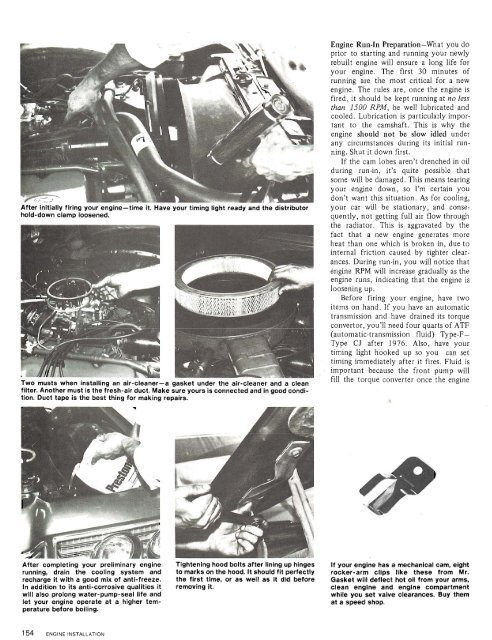How To Rebuild Your Ford V-8 351C-351M-400-429-460.pdf - Index of
How To Rebuild Your Ford V-8 351C-351M-400-429-460.pdf - Index of
How To Rebuild Your Ford V-8 351C-351M-400-429-460.pdf - Index of
Create successful ePaper yourself
Turn your PDF publications into a flip-book with our unique Google optimized e-Paper software.
b<br />
26- , .::<br />
.., . - -- a!,<br />
I<br />
After initially firing your engine-time it. Have your timing light ready and the distributor<br />
hold-down clamp loosened.<br />
Two musts when installing an air-cleaner-a gasket under the air-cleaner and a clean<br />
filter. Another must is the fresh-air duct. Make sure yours is connected and in good condition.<br />
Duct tape is the best thing for making repairs.<br />
Engine Run-In Preparation-What you do<br />
prior to starting and running your newly<br />
rebuilt engine will ensure a long life for<br />
your engine. The first 30 minutes <strong>of</strong><br />
running are the most critical for a new<br />
engine. The rules are, once the engine is<br />
fired, it should be kept running at no less<br />
than 1500 RPM, be well lubricated and<br />
cooled. Lubrication is particularly important<br />
to the camshaft. This is why the<br />
engine should not be slow idled under<br />
any circumstances during its initial running.<br />
Shut it down first.<br />
If the cam lobes aren't drenched in oil<br />
during run-in, it's quite possible that<br />
some will be damaged. This means tearing<br />
your engine down, so I'm certain you<br />
don't want this situation. As for cooling,<br />
your car will be stationary, and consequently,<br />
not getting full air flow through<br />
the radiator. This is aggravated by the<br />
fact that a new engine generates more<br />
heat than one which is broken in, due to<br />
internal friction caused by tighter clearances.<br />
During run-in, you will notice that<br />
engine RPM will increase gradually as the<br />
engine runs, indicating that the engine is<br />
loosening up.<br />
Before firing your engine, have two<br />
items on hand. If you have an automatic<br />
transmission and have drained its torque<br />
convertor, you'll need four quarts <strong>of</strong> ATF<br />
(automatic-transmission fluid) Type-F-<br />
Type CJ after 1976. Also, have your<br />
timing light hooked up so you can set<br />
timing immediately after it fires. Fluid is<br />
important because the front pump will<br />
fill the torque converter once the engine<br />
After completing your preliminary engine<br />
running, drain the cooling system and<br />
recharge it with a good mix <strong>of</strong> anti-freeze.<br />
In addition to its anti-corrosive qualities it<br />
will also prolong water-pump-seal life and<br />
let your engine operate at a higher temperature<br />
before boiling.<br />
Tightenlng hood bolts after linlng up hinges<br />
to marks on the hood. It should fit perfectly<br />
the first time, or as well as it did before<br />
removing it.<br />
If your engine has a mechanical cam, eight<br />
rocker-arm clips like these from Mr.<br />
Gasket will deflect hot oil from your arms,<br />
clean engine and engine compartment<br />
while you set valve clearances. Buy them<br />
at a speed shop.
















